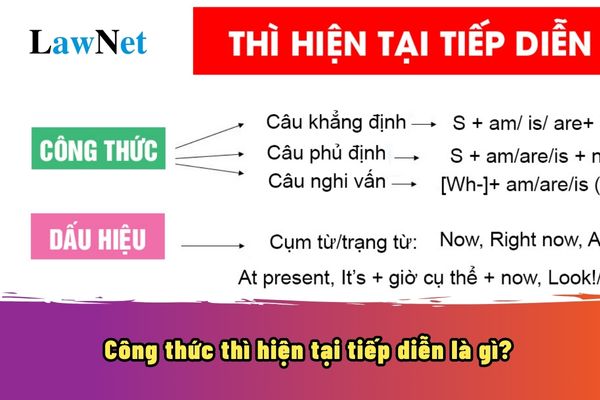Vietnam: What is the formula for the present continuous tense? What are the identification signs of the present continuous tense? What is the grade at which the English curriculum covers the present continuous tense?
What is the formula for the present continuous tense? What are the identification signs of the present continuous tense?
Present continuous tense
*Formula:
Affirmative: S + am/is/are + V-ing
Negative: S + am/is/are + not + V-ing
Interrogative: Am/Is/Are + S + V-ing?
Where:
S: Subject
am/is/are: To be
V-ing: Verb with -ing
*Identification signs of the present continuous tense:
Time adverbs: now, at the moment, at present, right now, look!, listen!, ...
Time phrases: at the moment, at present, now, these days, ...
Sensory verbs: look, feel, hurt, ache, smell, taste, sound
Continuous verbs: go, come, leave, arrive, stay, wait, work, study, read, ...
*Usage:
Describing an action happening at the moment of speaking:
Example: She is watching TV now.
Describing a temporary action happening around the moment of speaking:
Example: They are living in a hotel this week.
Describing an action that is about to happen in the near future, already planned:
Example: We are having a party tomorrow.
Describing a repeated action causing annoyance:
Example: He is always complaining.
*Examples:
I am studying English now.
They are playing football in the park.
She is not listening to music at the moment.
Are you eating dinner?
Note: The present continuous tense is not used with state verbs such as: know, believe, understand, love, hate, want, need, ...
Example:
I know him. (Not I am knowing him.)
*Note: The information is for reference only./.

What is the formula for the present continuous tense? What are the identification signs of the present continuous tense? What is the grade at which the English curriculum covers the present continuous tense? (Image from Internet)
What is the grade at which the English curriculum covers the present continuous tense?
According to Section 5 of the General Education Program for English (grades 3 to 12) issued together with Circular 32/2018/TT-BGDDT stipulating the language knowledge in the 3rd-grade English curriculum:
Language Knowledge
Phonetics
Single vowels, diphthongs, consonants, consonant clusters
Vocabulary
Words related to grade 3 topics and themes
Grammar
Simple present tense
present continuous tense
Simple sentence
Demonstrative pronouns:
this/that/these/those
There is/There are
Wh- questions: what, where, who, how, how old…
Yes/No questions
Command sentences: Stand up, please. Don’t talk, please,…
Modal verbs: may, can
Personal pronouns: I, you, he, she, it, we, they
Possessive adjectives: my, your, his, her, its, our, their
Nouns (singular, plural): pen(s), book(s), chair(s), ...
Descriptive adjectives: big, small, new, old, …
Quantifiers: a lot, many, some, ...
Conjunction: and
Articles: a/an, the
Prepositions (of place): in, at, on, ...
…
Thus, according to the program, the 3rd-grade English curriculum covers the present continuous tense.
What are the features of the English subject in the applicable general education program in Vietnam?
According to the general education program for English issued under Circular 32/2018/TT-BGDDT, the specific features of the subject are defined as follows:
- English is a compulsory subject in the general education program from grade 3 to grade 12. As one of the tool subjects in school, English not only helps students form and develop communication skills in English but also contributes to forming and developing general skills, to live and work more effectively, study well in other subjects, and learn throughout life.
- The English subject provides students with an important tool for international communication, helping them exchange information, and advance scientific and technical knowledge, land earn about cultures, thereby contributing to creating understanding between nations, forming a sense of global citizenship, and contributing to the development of personal qualities and competencies. Through learning English and exploring different cultures, students can better understand and appreciate their own language and culture.
- As a compulsory subject in the general education program, English directly relates to and interacts with many other subjects/educational content such as Literature/Vietnamese, Natural and Social Sciences, History and Geography, Arts, Physical Education, Information Technology, and experiential activities. English is also a tool for teaching and learning other subjects, especially Math and natural sciences.
- The basic objective of the general education program for English is to help students form and develop communication skills through practicing listening, speaking, reading, writing, and language knowledge (phonetics, vocabulary, grammar).
The communication skills and language knowledge are built on specific communication competence units, in topics and themes suitable to the needs and abilities of general education students to help them achieve the requirements specified in the 6-level foreign language proficiency framework used for Vietnam.
- The content of the general education program for English reflects the basic orientations stated in the overall general education program of the Ministry of Education and Training, specifically:
+ At the primary level (grades 3-5), teaching English helps students initially form and develop communication skills through the four skills of listening, speaking, reading, and writing, with more emphasis on the two skills of listening and speaking.
+ At the lower secondary level, English teaching continues to help students form and develop communication skills, while also developing thinking ability and enhancing students’ understanding of the culture and society of other countries as well as a deeper understanding of their own culture and society.
+ At the upper secondary level, English teaching helps students develop communication skills in English based on the foundation of the English program at the primary and lower secondary levels, equipping students with lifelong learning skills to continually learn and enhance work abilities in the future.

